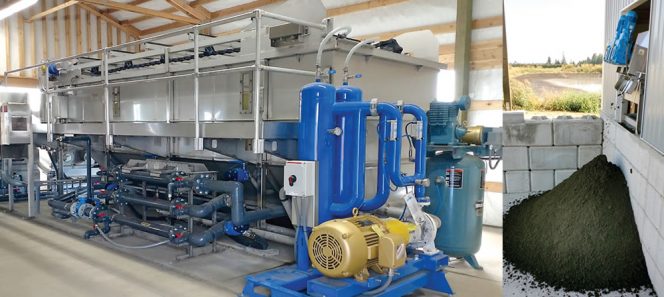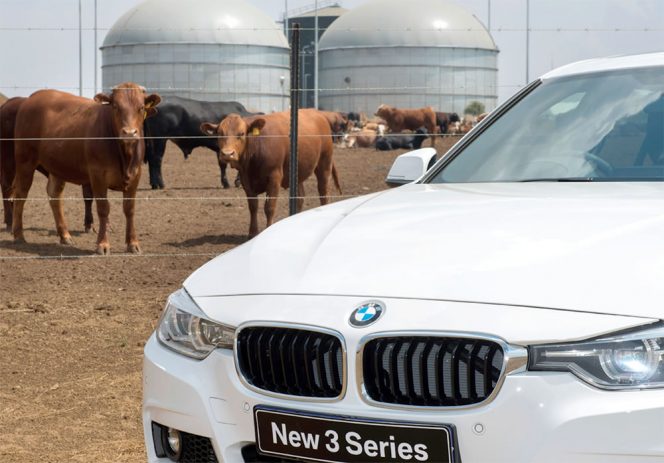BioCycle September 2017
Gauteng Province, South Africa: BMW Uses Cow Power To Make X3 Roadsters
The Bayerische Motoren Werke (BMW) Rosslyn plant in Pretoria is using renewable energy from an anaerobic digester in nearby Bronkhorstspruit to help make its line of X3 luxury compact sports utility vehicles. In 2014, BMW announced a power purchase agreement (PPA) with Bio2Watt (Pty) Ltd., which processes about 40,000 tons/year of cattle manure and 20,000 tons/year of mixed organic waste in two anaerobic digesters. Biogas is fed to a combined heat and power unit. The first delivery of renewable power to the BMW plant was in October 2015. Under the PPA, Bio2Watt is contracted to provide 4.4 megawatts/year — about 25 to 30 percent of the BMW plant’s electrical needs.
The Bio2Watt biogas plant in Bronkhorstspruit is located on the premises of one of South Africa’s larger feedlots (Beefcor). The location provides the project with grid access and sufficient water from Beefcor’s storm water collection dams. The City of Tshwane is a key supplier of waste to the project.
Los Angeles, California: Socalgas Opens Network To RNG
Southern California Gas Co. (SoCalGas), a subsidiary of Sempra Energy, launched an initiative to open the nation’s largest distribution pipeline network to renewable natural gas (RNG). Sempra Energy plans to accelerate the process for more in-state interconnections between RNG producers such as anaerobic digestion plants and the gas utility distribution network. The move is expected to encourage more RNG production facilities in California, which now has only two. A centerpiece is an internet-based downloadable toolkit the utility has developed to assist RNG producers and developers connect their projects to the SoCalGas system. The Los Angeles/Long Beach Ports boards recently embraced use of RNG, a move encouraged by the utility.
One issue SoCalGas is addressing in its RNG initiative is the minimum heating value requirements for gas supplies put into the utility pipeline system. Separately, the California Public Utilities Commission in April approved a process to accelerate interconnections by allowing earlier procurement of the needed materials by the parties involved. Previously the procurement could only be done after an interconnection study had been completed and a construction agreement executed.
A University of California, Davis, study estimated that gas needs of around 2.4 million California homes could be fueled with RNG derived from the state’s existing organic waste stream alone. Currently, 60 percent of the fuel used in California’s natural gas vehicles (NGV) is RNG, and SoCalGas expects that portion to increase to 90 percent in 2018.
London, England: Voluntary AD Certification
A pilot to improve the environmental, operational and safety performance of biogas plants has been launched by the Anaerobic Digestion and Bioresources Association (ADBA).
The three-month trial with a small group of food waste and agricultural plant operators aims to develop a voluntary certification scheme for the AD sector, due to launch this autumn. It is part of an ongoing project by association and industry partners, including the National Farmers Union (NFU) and the Country Land and Business Association (CLA).
The scheme brings together much of the legislation and standards that plant operators already have to comply with, according to an article in Farmers Weekly. It includes a host of criteria, such as managing health and safety and environmental risks, staff training, plant monitoring, equipment maintenance, digestate management and compliance with animal by-products regulations. Three checklists covering risk management, procurement and operational performance were published last July and will form the basis for the certification requirements. The certification scheme will be open to all AD operators outside the sewage treatment sector. The fee to join varies according to plant size.
Membership may result in lower regulatory fees and fewer site inspections, reduced insurance costs and more favorable terms, better financing deals, and may also highlight areas for improvement, according to Jessica Allen, ADBA’s environment and regulation manager. One insurance broker is offering a 10 percent discount to operators certifying under the best practice scheme.
Lynden, Washington: Dairy Digester Adds Phosphorus Recovery
 A recent development in on-farm manure and nutrient management is incorporation of fine solids separators (FSS) capable of separating fine solids and their associated nutrients from the wastewater. When paired with an anaerobic digester, these FSS units remove 85 percent of the phosphorus and 35 percent of the nitrogen from the digested slurry in a solid form. The phosphorus can be sold as a biofertilizer, or dairy farmers can more easily transport it to distant fields and more efficiently meet nutrient management plans. A FSS — the DVO Phosphorous Recovery System (PRS) — was recently commissioned at the Edaleen Dairy in Lynden. The dairy utilizes a DVO Mixed Plug Flow Digester and a Houle solid/liquid slope screen separator for production of fibrous solids bedding and soil amendment. The PRS, installed by Regenis to further treat the liquid stream, is a chemical precipitation technology that produces separated fine solids and a tea-colored irrigation water for use on local fields.
A recent development in on-farm manure and nutrient management is incorporation of fine solids separators (FSS) capable of separating fine solids and their associated nutrients from the wastewater. When paired with an anaerobic digester, these FSS units remove 85 percent of the phosphorus and 35 percent of the nitrogen from the digested slurry in a solid form. The phosphorus can be sold as a biofertilizer, or dairy farmers can more easily transport it to distant fields and more efficiently meet nutrient management plans. A FSS — the DVO Phosphorous Recovery System (PRS) — was recently commissioned at the Edaleen Dairy in Lynden. The dairy utilizes a DVO Mixed Plug Flow Digester and a Houle solid/liquid slope screen separator for production of fibrous solids bedding and soil amendment. The PRS, installed by Regenis to further treat the liquid stream, is a chemical precipitation technology that produces separated fine solids and a tea-colored irrigation water for use on local fields.
The Washington State Department of Commerce Clean Energy Fund program provided funding for demonstration of this new FSS technology. “Nutrient recovery is going to be a bigger and bigger deal moving forward,” said Edaleen Dairy’s Mitch Moorlag. “With current and future regulation, things aren’t getting easier for farmers and more tools are needed to help us achieve a higher level of stewardship of the land. With a FSS, I’ll need to buy less land, apply fewer nutrients to my land and not have to truck nutrients anymore. That’s what you call a winning triple bottom line.”
St. Louis, Missouri: Regional Biogas Project Advancing
In 2016, Roeslein Alternative Energy, based in St. Louis, built a $120 million anaerobic digestion plant to process hog manure just north of Albany. It has been slightly more than a year since the first volumes of conditioned biogas from the digester were injected into a pipeline. “There’s basically two markets that we’re selling to right now,” Brian Gale, Roeslein’s business development manager, told newpressnow.com: Duke Energy in North Carolina is contracted to purchase part of the processed fuel to help meet clean energy standards for power generation. Element Markets in California is using the fuel for its supply of compressed natural gas that benefits fleet vehicles.
Ruckman Farms in Gentry County was the first of nine farms selected to produce biogas for Roeslein. Two other Missouri farms, Locust Ridge near Harris and the Valley View near Milan, were both added to the collection network, Gale said. Smithfield Hog Production in north Missouri is partnering with Roeslein on the biogas operations. The Nature Conservancy has provided 1,000 acres of Dunn Ranch in Harrison County for research into deriving alternative fuel from the grasses.
Encina, California: Pilot Testing Codigestion
The Encina Wastewater Authority and Waste Management have launched a 90-day pilot project to codigest slurried food waste with biosolids in a digester at the treatment plant. During the pilot, Waste Management will transport the food waste from its Centralized Organic Recycling (CORe) installation in Orange County, California (see “Los Angeles County WRRF Embraces Co-Digestion,” January 2017) to the Encina plant. The slurry will be added into an isolated digester to compare methane production of that digester with others on site.
Karnataka, India: Iron Oxide Nanoparticles Accelerate AD
Researchers in India have demonstrated that addition of iron oxide nanoparticles to an anaerobic digester can increase biogas production and quality. A mix of dairy manure (25%) and food waste (75%) was digested with less than 0.2 percent (on a weight basis) iron oxide nanoparticles, which are between 50 and 300 nanometers in size (one-billionth of a meter).
Biogas production increased by almost 80 percent. The iron ions helped reduce carbon dioxide content from 40 to 35 percent in the final biogas product by converting some of the carbon to methane in the presence of hydrogen. The nanoparticles act as a reducing agent and also catalyze the reduction of carbon dioxide. One drawback of this approach, note the researchers, is that the potential environmental impact of nanoparticles is not very well understood. The full study appears in the September 2015 issue of the Journal of Chemical and Pharmaceutical Research.











